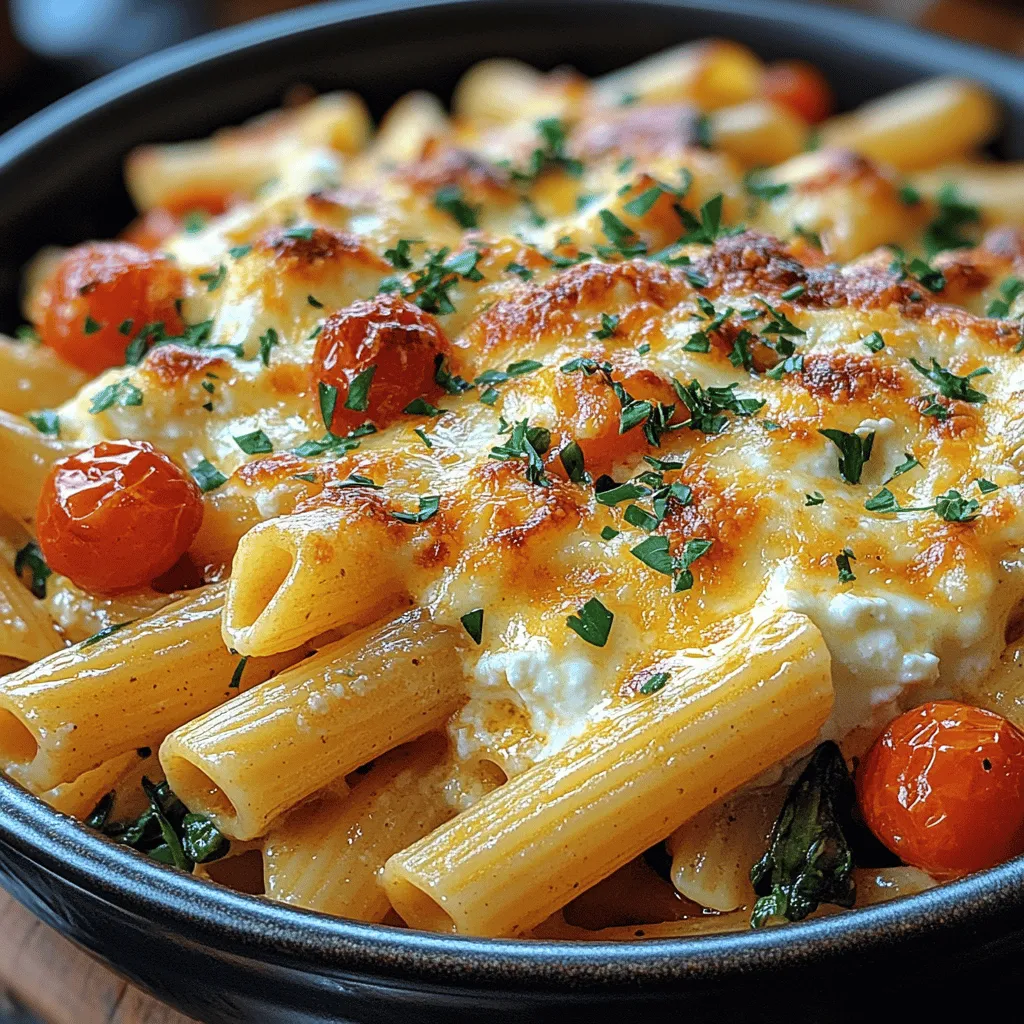Creamy Greek Pasta Bake: A Deliciously Easy Recipe
If you’re in search of a comforting yet nutritious dish that brings a taste of the Mediterranean to your table, look no further than the Creamy Greek Pasta Bake. This dish combines the richness of creamy ingredients with the vibrant flavors of Greek cuisine, making it an ideal choice for family dinners and social gatherings alike. With its effortless preparation and satisfying flavors, this pasta bake captures the essence of Greece, allowing you to savor the deliciousness without spending hours in the kitchen.
The Allure of Greek Cuisine
Greek cuisine is celebrated not only for its delightful flavors but also for its health benefits. Rooted in a rich history that dates back thousands of years, Greek cooking is part of the Mediterranean diet, renowned for its emphasis on fresh, wholesome ingredients. Olive oil, whole grains, fresh vegetables, and lean proteins are staples of this diet, contributing to its reputation as one of the healthiest in the world.
Incorporating Greek flavors into your meals allows you to enjoy not just delicious food but also a variety of nutritional benefits. Ingredients like olive oil are rich in healthy fats, while vegetables such as tomatoes and spinach are packed with vitamins and antioxidants. This makes Greek dishes not only tasty but also a smart choice for anyone looking to improve their diet.
A Simple Recipe for Everyone
The Creamy Greek Pasta Bake is particularly appealing for its simplicity. With minimal prep work and straightforward cooking steps, it’s a dish that anyone can master, regardless of their culinary skills. Whether you’re cooking for a busy weeknight dinner or hosting friends for a casual weekend gathering, this recipe caters to all occasions. It’s a delightful way to introduce the flavors of Greece to your family while providing a satisfying meal that everyone will enjoy.
Understanding Greek Cuisine
Greek cuisine has deep roots, influenced by various cultures throughout history, including the Minoans, Mycenaeans, and later the Romans and Ottomans. This rich tapestry of history has contributed to the diversity of flavors and ingredients found in modern Greek cooking. The emphasis on fresh, seasonal produce and local ingredients is a hallmark of this cuisine, making it not only delicious but also sustainable.
Key ingredients commonly found in Greek dishes include olive oil, fresh herbs, yogurt, feta cheese, and a variety of vegetables. These ingredients contribute to the distinct flavors that characterize Greek cooking, with an emphasis on balance and harmony in every dish.
The health benefits of incorporating Greek flavors into your meals are significant. The Mediterranean diet, which includes Greek cuisine, has been linked to numerous health advantages, including reduced risk of heart disease, improved cognitive function, and better weight management. By embracing these ingredients, you can enjoy not only the taste of Greece but also a healthier lifestyle.
Ingredients Breakdown
To prepare a Creamy Greek Pasta Bake, you’ll need a selection of high-quality ingredients that contribute to the dish’s flavor and nutritional value. Here’s a detailed breakdown of the key components:
– Penne Pasta: The star of the dish, penne pasta is chosen for its tubular shape, which allows it to hold onto the creamy sauce and other ingredients beautifully. Cooking the pasta al dente is crucial, as it will continue to cook in the oven, preventing it from becoming mushy.
– Spinach: Fresh spinach adds a vibrant color and a wealth of nutrients, including iron and vitamins A and C. It also provides a slight earthy flavor that complements the creaminess of the dish.
– Cherry Tomatoes: These sweet, juicy tomatoes add freshness and a burst of flavor. They also bring a hint of acidity, balancing the richness of the other ingredients.
– Bell Pepper: Bell peppers contribute a crunchy texture and a mild sweetness. They are loaded with vitamins A and C, making them a healthy addition to the dish.
– Greek Yogurt: This ingredient is essential for achieving the creamy texture that defines the bake. Greek yogurt is thicker than regular yogurt and offers a tangy flavor while also being lower in fat compared to heavy cream.
– Feta Cheese: A staple in Greek cuisine, feta cheese adds a salty, tangy flavor that elevates the dish. Its crumbly texture contrasts wonderfully with the creamy elements of the bake.
– Spices and Herbs: Oregano, basil, and red pepper flakes are used to season the dish, infusing it with traditional Greek flavors. Oregano, in particular, is a hallmark of Greek cooking, providing an aromatic quality that enhances the overall taste.
Step-by-Step Preparation Guide
Before diving into the preparation of your Creamy Greek Pasta Bake, it’s important to preheat your oven to ensure even cooking. A properly heated oven helps to achieve that perfect golden-brown top while ensuring that the pasta is cooked through.
Cooking Al Dente Pasta: One of the most crucial steps in preparing this bake is cooking the penne pasta to al dente. This means that the pasta should be firm to the bite, as it will continue to absorb moisture and cook further during the baking process. To achieve this, boil the pasta in salted water for about 2 minutes less than the package instructions recommend. This will prevent the pasta from becoming overly soft when baked.
Following these initial steps sets the stage for a delightful culinary experience. With the oven preheated and your pasta cooked to perfection, you can move on to combining the ingredients and assembling your Creamy Greek Pasta Bake. Each step builds on the last, creating a dish that is not only easy to prepare but also bursting with the flavors of Greece.

Tips for Sautéing Vegetables to Enhance Flavor
Sautéing vegetables is an art that can significantly enhance the overall flavor of your Creamy Greek Pasta Bake. Here are some tips to ensure your vegetables are bursting with taste:
1. Choose Fresh Ingredients: Select fresh, vibrant vegetables like bell peppers, zucchini, and spinach. Fresh produce not only adds color but also enhances the flavor profile of the dish.
2. Use Enough Oil: When sautéing, use enough olive oil to coat the bottom of your pan. This prevents sticking and helps in even cooking. A good rule of thumb is about 1-2 tablespoons per cup of vegetables.
3. High Heat: Preheat your pan over medium-high heat before adding the oil. Once the oil shimmers, add your vegetables. This quick cooking method preserves their color, texture, and nutrients.
4. Don’t Overcrowd the Pan: If you add too many vegetables at once, they will steam instead of sautéing. Cook in batches if necessary, allowing space for each piece to brown properly.
5. Season as You Go: Add a pinch of salt while sautéing to draw out moisture and enhance the natural flavors of the vegetables. You can also incorporate herbs like oregano or thyme at this stage for added depth.
6. Cook Until Tender: Aim for a tender-crisp texture. Vegetables should be bright and colorful, not mushy. This will ensure they retain a satisfying bite in your pasta bake.
How to Properly Mix Ingredients to Ensure Even Distribution of Flavors
Mixing your ingredients thoroughly is crucial to achieving a well-balanced flavor in your Creamy Greek Pasta Bake. Here’s how to ensure even distribution:
1. Use a Large Bowl: Start with a spacious mixing bowl. This allows for easier tossing and prevents ingredients from flying out during mixing.
2. Layer Ingredients Gradually: Begin by adding your cooked pasta at the bottom. Next, layer in the sautéed vegetables, followed by your creamy sauce. This technique helps the sauce to cling to the pasta and vegetables evenly.
3. Toss Gently: Use a spatula or large spoon to gently fold the ingredients together. Avoid aggressive stirring, which can break the pasta and vegetables apart.
4. Check for Consistency: Ensure that every piece of pasta and vegetable is coated with sauce. If it seems too dry, consider adding a splash of vegetable broth or a bit more sauce to moisten it up.
5. Taste as You Go: Always taste your mixture before assembling the bake. This allows you to adjust seasoning as needed, ensuring a well-rounded flavor profile.
Assembling the Bake: Techniques for Layering and Presentation
When it comes to assembling your Creamy Greek Pasta Bake, presentation can make a significant difference. Here are some techniques for layering and serving:
1. Start with Sauce: Begin by spreading a thin layer of the creamy sauce on the bottom of your baking dish. This prevents the pasta from sticking and adds moisture from the start.
2. Layer Strategically: Add half of your pasta mixture first, followed by a layer of cheese. Then, add the remaining pasta and top with the rest of the cheese. This not only enhances flavor but also creates a beautiful cheesy crust.
3. Finish with Fresh Herbs: Before baking, sprinkle some fresh herbs like parsley or basil on top. This adds a pop of color and freshness to the dish.
4. Use a Shallow Baking Dish: A wider, shallow baking dish allows for even cooking and browning. This results in a beautifully golden top that is appealing to the eye.
5. Cover for the First Half of Baking: If you want to prevent the top from burning, cover the dish with aluminum foil for the first half of the baking time. Remove the foil for the last 15-20 minutes to achieve that desirable bubbly top.
Baking the Creamy Greek Pasta Bake
Baking your Creamy Greek Pasta Bake is where the magic happens. Here’s what you need to know:
Explanation of Baking Time and What to Look for to Ensure Doneness
The baking time for your pasta bake is typically around 30-40 minutes at 375°F (190°C). To ensure doneness:
– Look for Bubbling Edges: The sides of the dish should be bubbling, indicating that the sauce is hot and the pasta is absorbing flavors.
– Check the Cheese: The cheese should be melted and beautifully golden brown on top. If it’s not bubbling after 30 minutes, give it a few more minutes while keeping an eye on it to avoid burning.
– Use a Toothpick: Insert a toothpick or knife into the center of the bake. If it comes out hot and clean, your dish is ready.
The Role of Cheese in Creating a Golden, Bubbly Top
Cheese plays a vital role in the overall success of your Creamy Greek Pasta Bake. Here’s how:
– Melting Point: Cheese melts during the baking process, creating that gooey texture that makes pasta bakes irresistible.
– Browning: As cheese bakes, it undergoes the Maillard reaction, which is responsible for the golden-brown color. This not only enhances flavor but also adds an appealing visual element.
– Texture Contrast: The creamy sauce combined with the cheesy top creates a delightful contrast in texture, making each bite satisfying.
The Science Behind Baking Pasta Dishes and How It Enhances Flavors
Baking pasta dishes like the Creamy Greek Pasta Bake allows flavors to meld and deepen. Here’s why:
– Flavor Concentration: As the dish bakes, the moisture evaporates slightly, concentrating the flavors. The combination of cream, cheese, and sautéed vegetables creates a rich taste that’s more pronounced than when ingredients are simply mixed and served.
– Ingredient Interaction: The heat from baking allows the ingredients to interact, enhancing the overall flavor. For instance, the savory notes of garlic and onion from the sautéed vegetables blend beautifully with the cream and cheese.
– Texture Development: Baking creates a unique texture that is difficult to achieve through stovetop cooking alone. The edges of the pasta may crisp slightly, while the center remains creamy, offering a delightful eating experience.
Serving Suggestions
Once your Creamy Greek Pasta Bake is out of the oven, it’s time to consider how to serve it:
Ideas for Side Dishes That Pair Well with the Pasta Bake
1. Greek Salad: A refreshing Greek salad with cucumbers, tomatoes, olives, and feta complements the richness of the pasta bake perfectly.
2. Garlic Bread: Serve warm garlic bread on the side for those who love a crunchy contrast to the creamy pasta.
3. Roasted Vegetables: Lightly roasted seasonal vegetables like asparagus or carrots add color and a healthy touch to your meal.
4. Tzatziki Sauce: Offer a side of tzatziki for a cool, tangy dip that enhances the Greek flavors of your dish.
Creative Ways to Garnish the Dish for Aesthetic Appeal
1. Fresh Herbs: A sprinkle of freshly chopped parsley or dill on top adds a burst of color and freshness.
2. Lemon Zest: A light dusting of lemon zest can elevate the dish, adding a zesty aroma that complements the creamy base.
3. Crushed Red Pepper Flakes: For those who enjoy a bit of heat, a sprinkle of crushed red pepper flakes can add both color and a spicy kick.
Discussion on Portion Sizes and How It Fits Into Meal Planning
When it comes to portion sizes for your Creamy Greek Pasta Bake, consider the following:
– Serving Size: A typical serving is about one cup, which is satisfying for most adults. Adjust portions based on your family’s appetite and dietary needs.
– Meal Planning: This dish is perfect for meal prep. It can easily be made ahead of time and stored in the refrigerator for up to three days. Reheat portions in the oven or microwave, making it a convenient option for busy weeknights.
– Freezing: If you want to make it ahead of time, the pasta bake freezes well. Allow it to cool completely before wrapping it tightly and storing it in the freezer for up to three months.
Nutritional Information
Understanding the nutritional content of your Creamy Greek Pasta Bake can help you enjoy it guilt-free. Here’s a breakdown:
– Calories: Approximately 350 calories per serving, depending on the specific ingredients used.
– Protein: Each serving contains around 15 grams of protein, primarily from the pasta and cheese.
– Fats: Expect about 15 grams of fat, with healthy fats coming from olive oil and cheese.
– Carbohydrates: A serving typically has around 40 grams of carbohydrates, which provides energy.
Discuss the Health Aspects of the Dish, Including Its Vegetarian-Friendly Nature
This Creamy Greek Pasta Bake is not only delicious but also vegetarian-friendly, making it a great option for those seeking plant-based meals. The inclusion of vegetables boosts its nutritional profile, providing vitamins and minerals essential for a balanced diet.
– Fiber: The vegetables contribute dietary fiber, which aids digestion and keeps you feeling full.
– Calcium: The cheese adds calcium, which is vital for bone health, making it a nutritious option for vegetarians.
How This Dish Can Be Modified for Dietary Restrictions
1. Gluten-Free Options: Substitute traditional pasta with gluten-free pasta made from rice, quinoa, or chickpeas.
2. Dairy-Free Alternatives: Use dairy-free cheese or a cashew-based cream to make the dish suitable for those with dairy intolerance. Nutritional yeast can also be added for a cheesy flavor without the dairy.
3. Lower-Calorie Variations: To reduce calories, consider using whole grain pasta and low-fat cheese options.
Conclusion
The Creamy Greek Pasta Bake is a delightful dish that embodies the essence of comfort food while being easy to prepare. With its rich flavors, creamy texture, and the ability to customize to dietary needs, it’s perfect for family dinners or gatherings.
Cooking is a joyous experience, especially when you can share a delicious meal with loved ones. We encourage you to try this recipe, explore various ingredient combinations, and enjoy the delightful process of creating and sharing meals. Whether it’s a weeknight dinner or a festive occasion, this pasta bake is sure to impress and satisfy!


